Hey, we are all here because we LOVE Great Danes. The decision of whether to breed a Great Dane is a weighty and multifaceted consideration that requires careful thought and responsible decision-making.
It’s tempting to jump right into the process because your pet is wonderful with kids and a great family member. Beyond the allure of the breed’s majestic presence and gentle temperament, prospective breeders must consider the complexities of responsible breeding, acknowledging the significant responsibilities that come with bringing new lives into the world.
This introspective process demands an understanding of the dog’s health, genetics, and the commitment required to ensure the well-being of both the dam and the potential litter. Aspiring breeders must grapple with ethical concerns surrounding overpopulation, the potential for genetic issues, and the extensive care needed for both the mother and the offspring.
Diving into the question of whether to breed a Great Dane necessitates a deep examination of one’s motivations, resources, and dedication to upholding the highest standards of canine welfare.
Are you thinking of breeding your amazing Great Dane?
Read on friend!

Reasons That You May Want to Breed Your Pet
Ask any Great Dane owner what they think of their dog. Every single one will tell you that theirs is the best. All of us love our dogs and are attached to everything about them; their personalities, their unique markings, the way that they walk.
Look at this list and ask yourself what reasons you have for breeding your dog:
- Love for the Breed: A genuine passion for the specific breed, such as the Great Dane, and a desire to contribute positively to its community and the written breed standard.
- Desire for a Similar Companion: Wanting to replicate the positive traits, temperament, and appearance of one’s beloved pet for personal enjoyment.
- Financial Incentives: The potential financial gains from selling puppies, especially if the dog comes from a recognized and desirable lineage.
- Educational Purpose: A wish to experience the miracle of birth and educate oneself about the complexities of canine reproduction.
- Preservation of Lineage: A commitment to preserving the lineage and bloodline of a particular breed, especially if the dog has exceptional traits.
Those reasons come with considerations, too, that should be taken very seriously. How much responsibility are you willing to take for the realities of breeding?
Before you take another step towards breeding your dog, put some time into your evaluation of the following considerations:
- Overpopulation Concerns: Awareness of the global issue of pet overpopulation, leading to millions of dogs in shelters, and the ethical responsibility to avoid contributing to the problem.
- Health and Genetic Considerations: Understanding the potential risks of passing on genetic diseases or health issues, and the importance of thorough health screenings for the breeding pair.
- Time and Commitment: Recognizing the considerable time, effort, and resources required for the health and well-being of the mother and the puppies, including proper care during pregnancy, whelping, and postnatal care.
- Screening and Responsible Ownership: Emphasizing the importance of thoroughly screening potential homes for the puppies and promoting responsible ownership to ensure a lifelong commitment to the dogs.
- Ethical Breeding Practices: The commitment to adhering to ethical breeding practices, including proper socialization of puppies, ensuring suitable living conditions, and supporting buyers throughout the dogs’ lives.
- The Health of Your Pet: breeding and whelping are a serious and risky business. Never breed a pet you aren’t willing to lose.
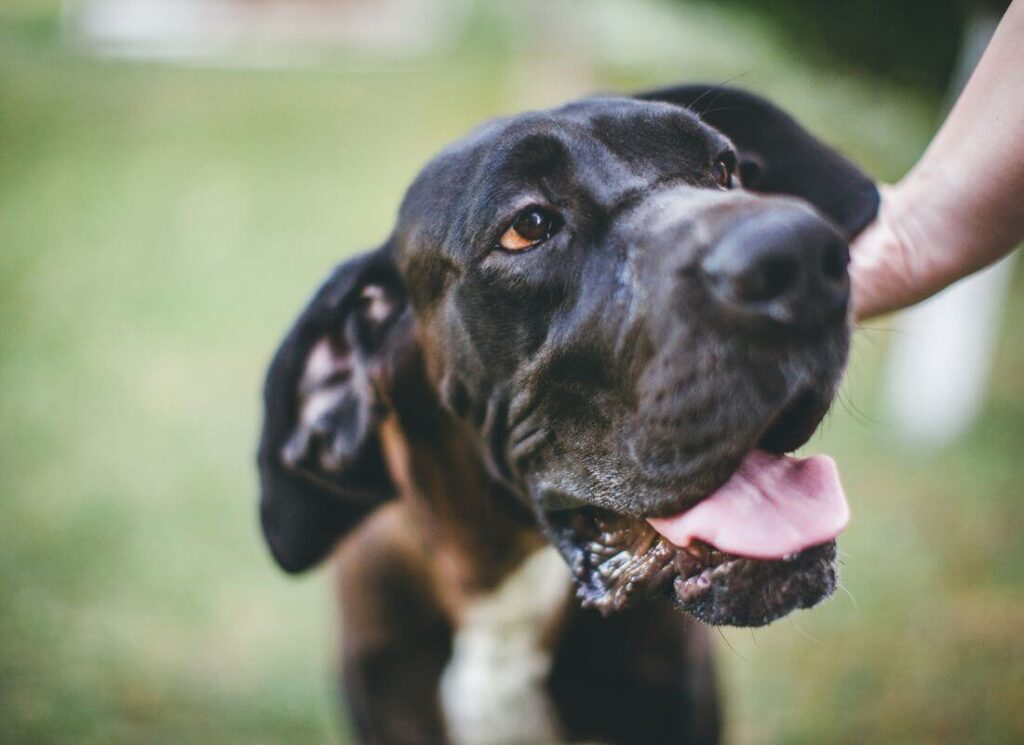
The Great Dane Breeding Checklist
Here is a checklist to follow before breeding your Great Dane. We will outline this in more detail below. If your dog doesn’t meet all of these basics, they should not be bred!
Which ones apply to your pet?
- The dog has a known pedigree
- The pedigree is free of wobblers, bloat, serious aggression, fearful/timid behavior, IMGD, heart disease, blood clotting disorders, degenerative disorders, and hip or elbow dysplasia.
- You have studied the pedigree and believe it to be free of those conditions
- The dog has full registration (a limited registration indicates that the dog should not be bred)
- Full health testing: eyes, heart, hips, thyroid and genetic testing and color screening has been completed and passed
- The dog has a stable, confident, friendly temperament with humans and other animals
- The dog is at least age 2, and if female under the age of 5
- The dog has excellent structure and gait to pass on to the puppies (Visit the Great Dane Conformation Clinic on Facebook for honest feedback).
- You are diligent in choosing a partner to pair your dog with
- You are willing to support puppy buyers for life
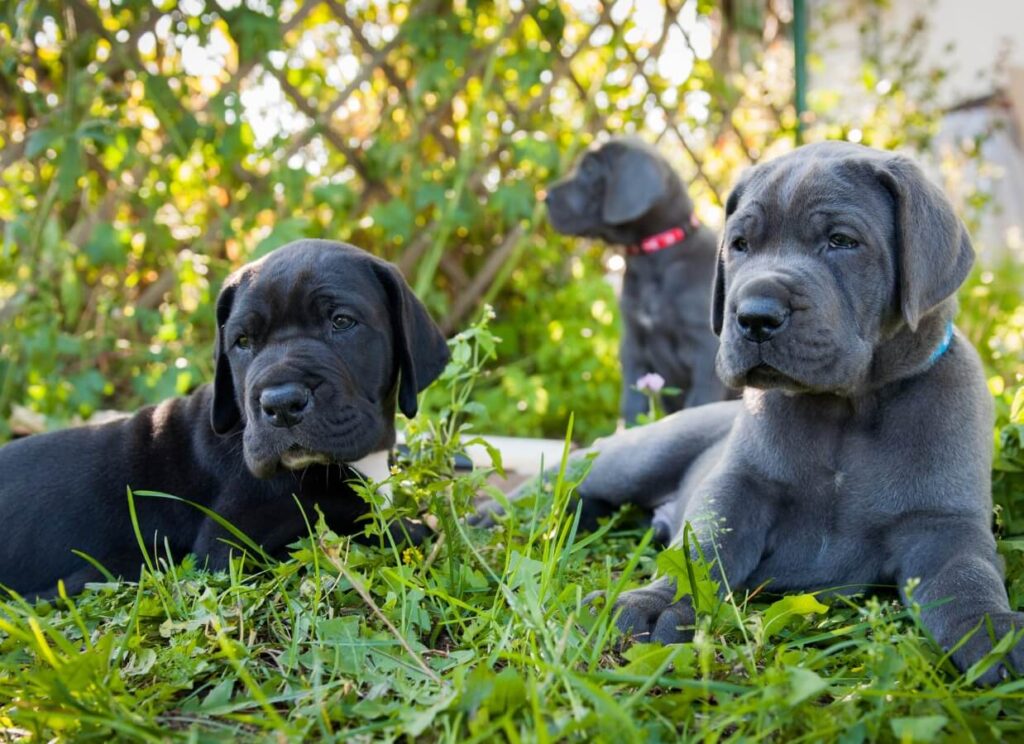
Should I Breed My Great Dane?
If you’ve gotten this far and are still asking this question, we are ready to dig in!
All breeders start somewhere, and asking this question is the first step!
AKC Registrations and Papers
AKC papers are helpful, but they are NOT an indicator of quality.
AKC papers show that the dog came from a lineage of other Great Danes. They don’t show if the puppies came from a lineage of robust, healthy, well-built dogs.
You can see this at play often: many people with purebred AKC Great Danes are still struggling with devastating issues including aggression, arthritis, ACL tears, heart disease, wobblers, and degenerative disorders.
Some AKC ‘purebred’ Great Danes don’t even look like Great Danes because breeders weren’t being careful or selective with their pairings.
Having AKC papers in the U.S. (or Canadian Kennel Club for Canada, FCI for Europe) is important as it helps document lineage and shows puppy buyers that they are getting a purebred dog.
Read our blog post about AKC Papers here.
We have seen some positively sketchy ‘AKC’ Great Danes.
Papers are NOT enough to make a breeding decision though. It’s that simple.
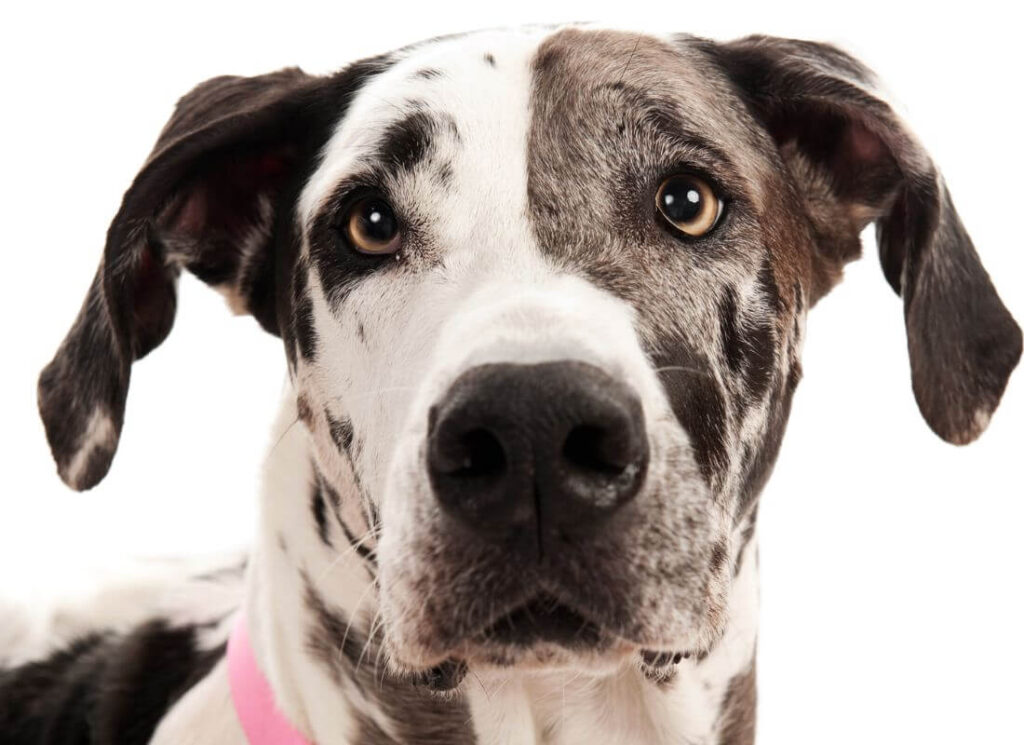
Structure, Movement, and Breed Standard
You don’t need a show dog to breed dogs, but you should be thoughtful about what genetics you are passing along.
Having a neat color, great personality or a ‘Euro’ look simply isn’t enough.
If all you see are positive things, remember this. All dogs have faults, and for every positive thing they pass on, they pass on their faults, too.
Whether we like it or not, all dogs have some fault or another. Even the most well-kept, well-bred beautiful show dogs will have something minor that isn’t ‘perfect’.
Those faults lie in their genetics, and breeding is how you either continue or discontinue faults.
Some common and unacceptable faults in Great Danes include:
- Roach, sloping or sway back
- Narrow hips
- Overbite or underbite
- Hip or elbow dysplasia
- Droopy eyes
- Excessive jowls/flew/drool
- Apple or dome-shaped head
- Wide-set eyes
- Sloping stop
- Stick out or hound ears
- Incorrect ‘Dane’ look in the head overall
- Poorly developed feet, flat feet, stick-out feet
- Weak pasterns
- Cow hocks
- Lack of substance
- Flat chest/front
- Poor angulation
- Over angulation
- Wear rear
- Double merle
- Aggression
- Fearful or timid behavior
- Genetic propensity towards dysplasia, bloat, wobblers, cancer, blood clotting disorders, or heart disease
Can you evaluate your dog objectively? If you aren’t sure, you can always ask for help!
Understanding angulation and overall structure requires an educated eye.
This is important because poor structure leads to pain and mobility problems later in life; poor genetics should not be intentionally passed on.
Here is an image of a correctly structured Great Dane.
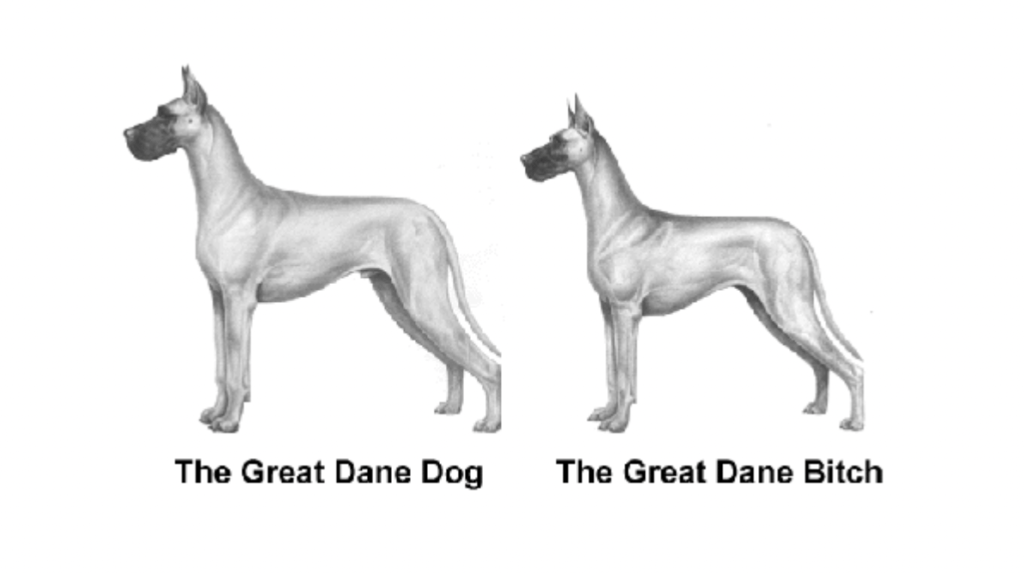
Ask in one of the many conformation groups on Facebook (post photos of your dog and they can tell you where the faults and strengths are) and get into the show ring with your Dane (there are fun conformation classes you can take to learn how).
Find a mentor through your local GDCA breed club.
Temperament & Personality
Temperament is equally important! Great Danes should be reliable, friendly, and confident. Danes with excellent temperaments will be easy to train and can pass a Canine Good Citizen test.
They should not be fearful, flighty, or unstable in any way.
Because temperament is largely genetic, it’s important that you only breed your dog if it has an exceptional and stable personality.
As the breeder, you should also be willing to dedicate a lot of time to the young puppies in your home by socializing them appropriately before they are sent home at 8-12 weeks of age.
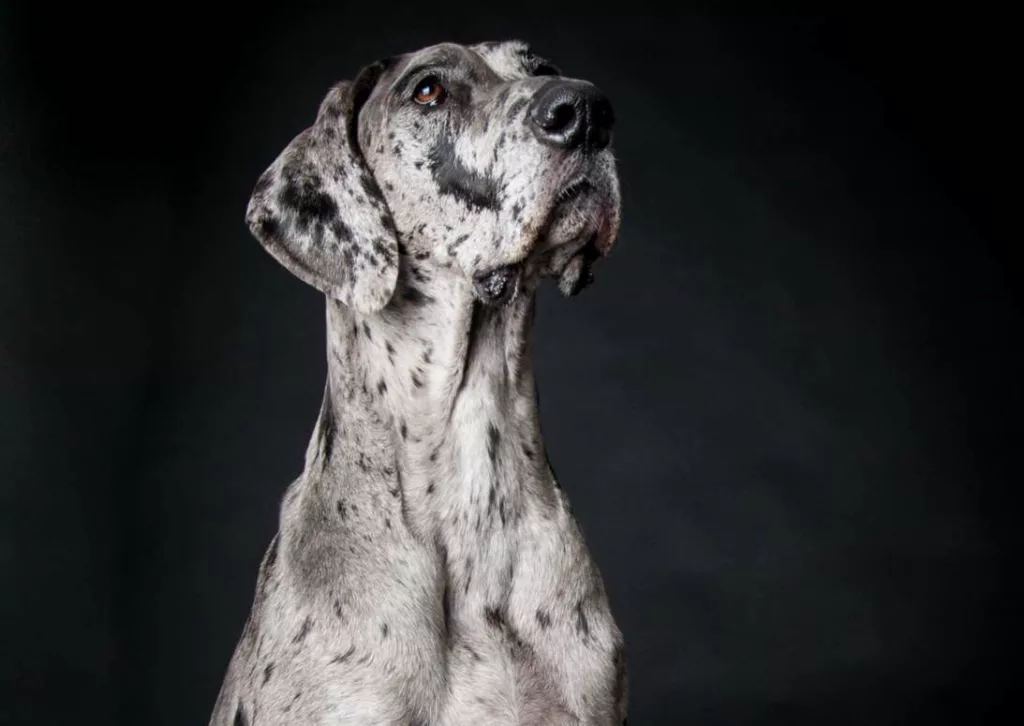
Breeding Rights & Limited Registrations
Make sure you reference the contract that you signed when you purchased your Great Dane.
- Is there any language in there restricting you from breeding your dog?
- Do you need to talk to the original breeder first?
- Did your breeder sell your puppy with Limited AKC Registration (meaning that you will NOT be able to register or paper the puppies that are produced from the litter)?
If your breeder didn’t outline these things, doesn’t care, had no restrictions, or didn’t have a contract in the first place you should NOT be breeding your dog.
These things are red flags for unethical breeding practices and indicate that your pup likely comes from questionable genetics.
Your Great Dane may be a wonderful family pet, but he/she isn’t likely to meet a reasonable standard for breeding quality.
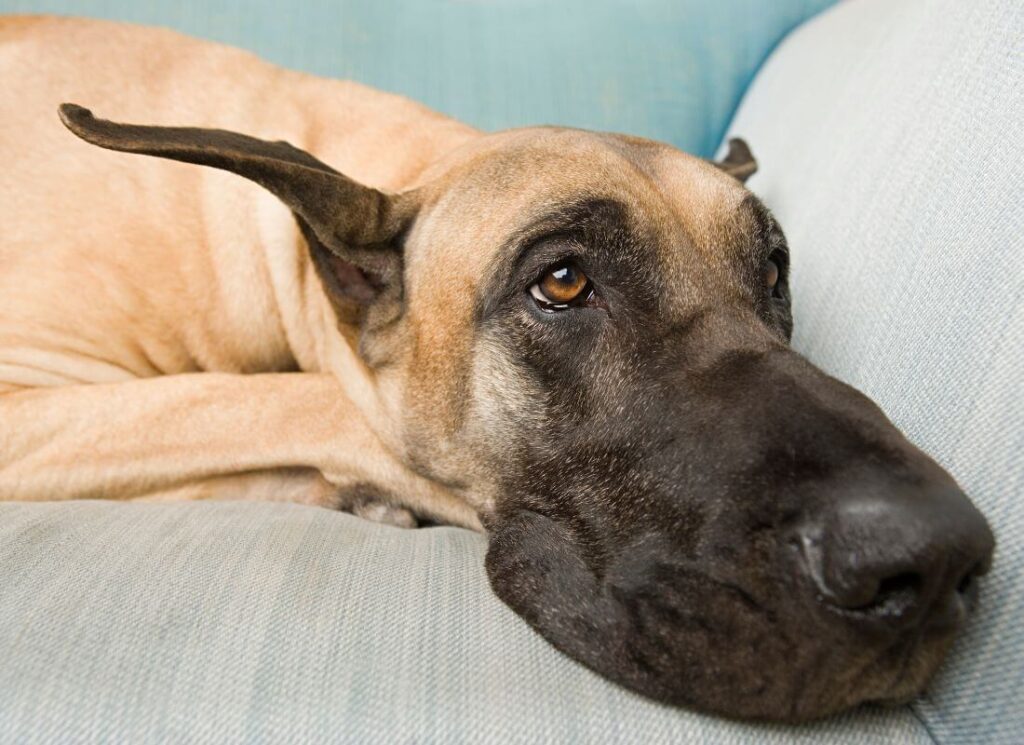
Great Dane Health Testing
A vet check is not enough.
If you want to breed your dog, visit www.ofa.org and view the current requirements for fully health-testing Great Danes.
At a minimum, your dog will need to have and pass the following health tests before breeding:
- X-rays to assess hip quality
- Eye exam by a Board-Certified Veterinary Ophthalmologist
- Echocardiogram to assess heart health and rule out primary DCM and heart disorders
- Thyroid panel to assess thyroid function
Both the DAM and the SIRE will require these tests, which can run upwards of $2-4K for each dog.
It is flat-out irresponsible to breed without completing, passing, and submitting these tests to www.ofa.org.
If you don’t know for a fact that your dog is free of significant, painful, and/or life-threatening faults then you should not proceed. An Embark panel does not count.
Additional Health Screenings
If you want to be extra diligent and ethical, you may also want to perform the following screenings, especially if your Great Dane doesn’t come from an already exceptional and known pedigree:
- Temperament test
- Elbow dysplasia
- IMGD
- Bloat
- Degenerative Myelopathy
- Color testing (more on this below)
We do not condone the practice of breeding dogs without full OFA health tests, and if you choose to continue without them, we no longer support you. It is even more offensive to set up a website with a breeder/kennel name and continue without this testing.
Puppy buyers are becoming more and more savvy about this. It can be extremely difficult to sell puppies from untested parents, because people are seeing just how heartbreaking it is when Great Danes receive preventable structural, growth and health faults.
If the dog you want to breed came from parents who were not fully health tested as outlined above, these things are even more important.
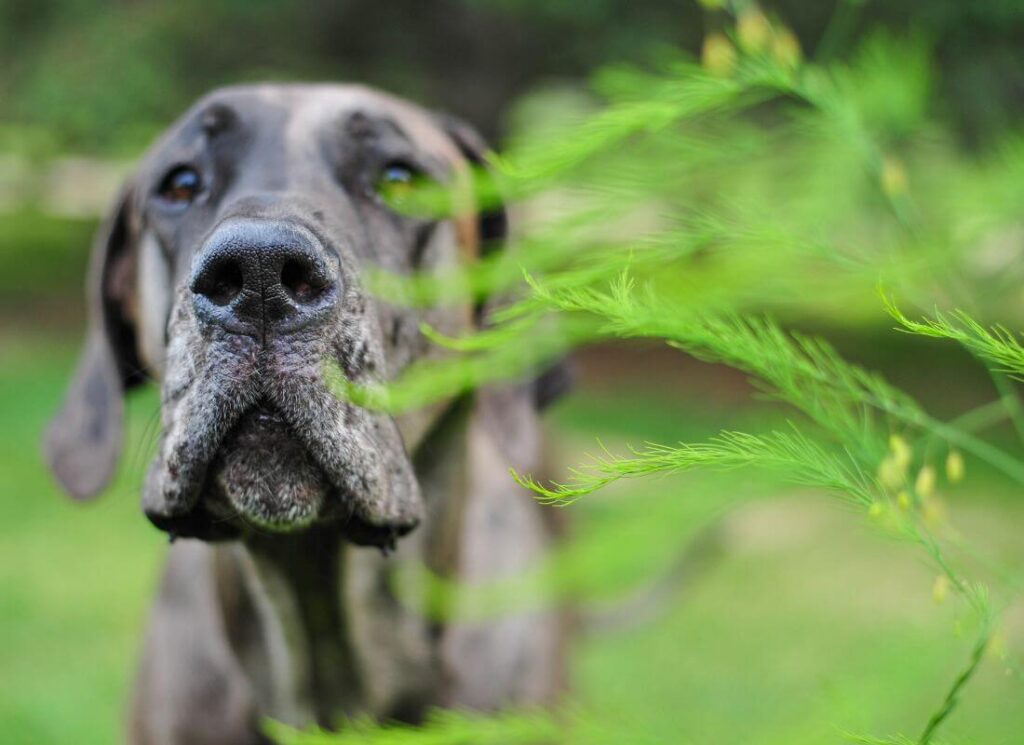
Color Testing in Great Danes
Great Danes come in a rainbow of colors!
As of this writing, only 7 are accepted within the breed standard.
All other colors may be beautiful but are considered faults. Some of these colors may cause health problems, too. Other colors are generally harmless.
Color testing can help you determine what colors your dog carries and might pass on to the puppies.
This is especially important if you aren’t as clear on the colors within your pedigree.
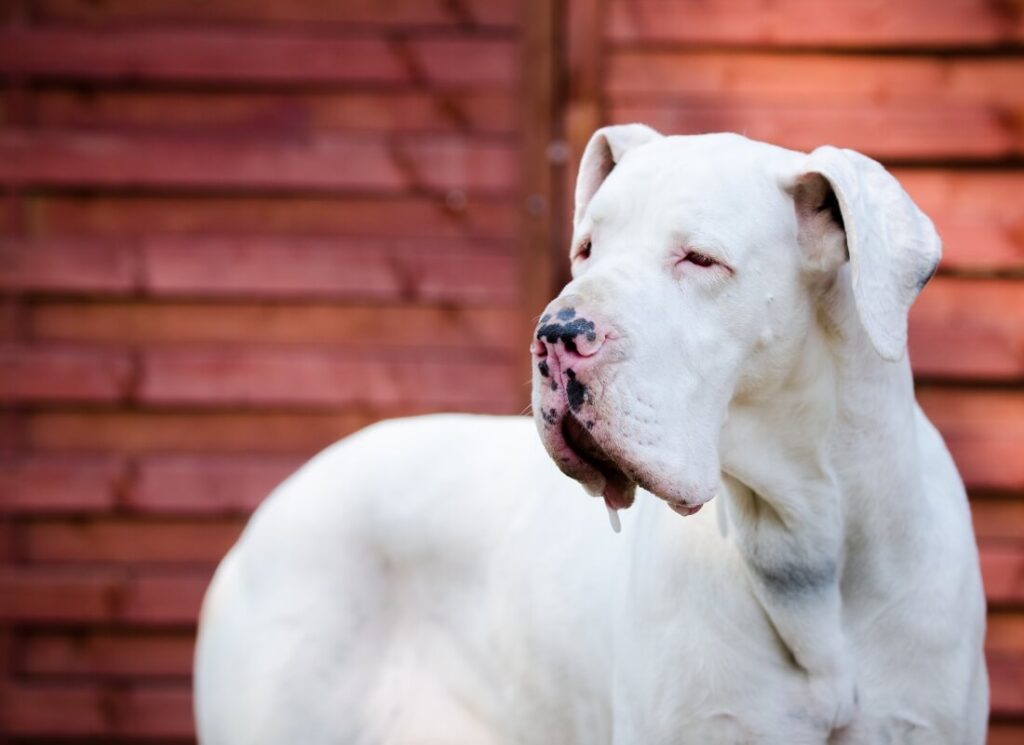
Double-Merle Great Danes
A primary reason for color testing is to prevent creating double-merle puppies.
Double merle puppies are dogs that received two merle genes: one from each parent.
Puppies with two merle genes are often white or mostly white and may:
- Be deaf or blind
- Have health problems, including autoimmune disorders
- Struggle with confidence and training, and might have temperament problems such as aggression
- Be difficult to place with families
- Die in the womb
For this reason, only ONE parent should carry Merle in their color genetics.
Color testing is one way to ensure that your dam+sire pairing is a solid, safe, and ethical match.
You can learn more about Great Dane color testing here: https://vgl.ucdavis.edu/panel/dog-coat-color-great-dane
What Age Can Great Danes Be Bred?
OFA health testing cannot be completed until the age of 2+. Thus, age 2 is the minimum age when you can consider breeding a Great Dane.
Not only that, but you can’t fully evaluate a Great Dane’s mature structure until they are at least that age.
Males in particular tend to mature slowly; you do not want to breed a still-growing 18-month-old Sire and then find out that they never really fill out correctly (and passed on a poor substance to the puppies).
Patience is a virtue here! It’s important to allow Great Danes their full chance to develop before asking them to breed for you.
Females especially should never be bred before the age of 2. Breeding uses up a lot of nutrients and resources that are necessary for bone and heart health, two things that young Danes especially need to focus on. For the health, safety, and comfort of the bitch, she should not be bred before full maturity.
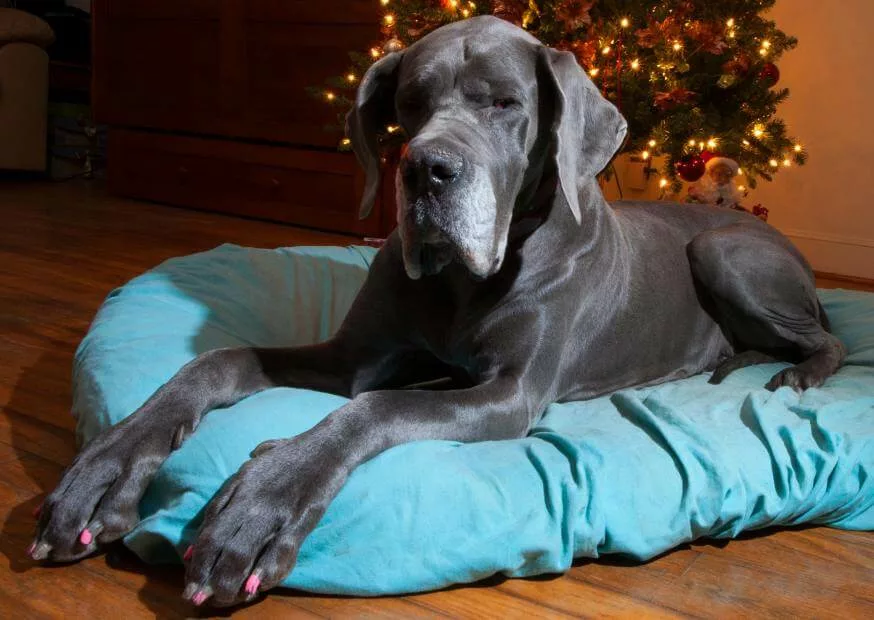
Has your dog been bred before?
No Dam/Bitch should ever be asked to breed more than 2-4 times. So if you’ve reached that point, STOP.
If your Dam or Sire has produced a litter in the past, what were the litters like?
Were the puppies solid, healthy, robust, curious, and friendly?
Did they become quality pets?
Did any of them have significant structural problems, health issues, or faults?
Have any of those puppies developed bloat, aggression, autoimmune disorders (including allergies), heart problems, limb deformities, blood clotting problems, seizures, diabetes, or thyroid issues?
Don’t breed again if your breed choices are not producing dogs that serve to improve the breed.
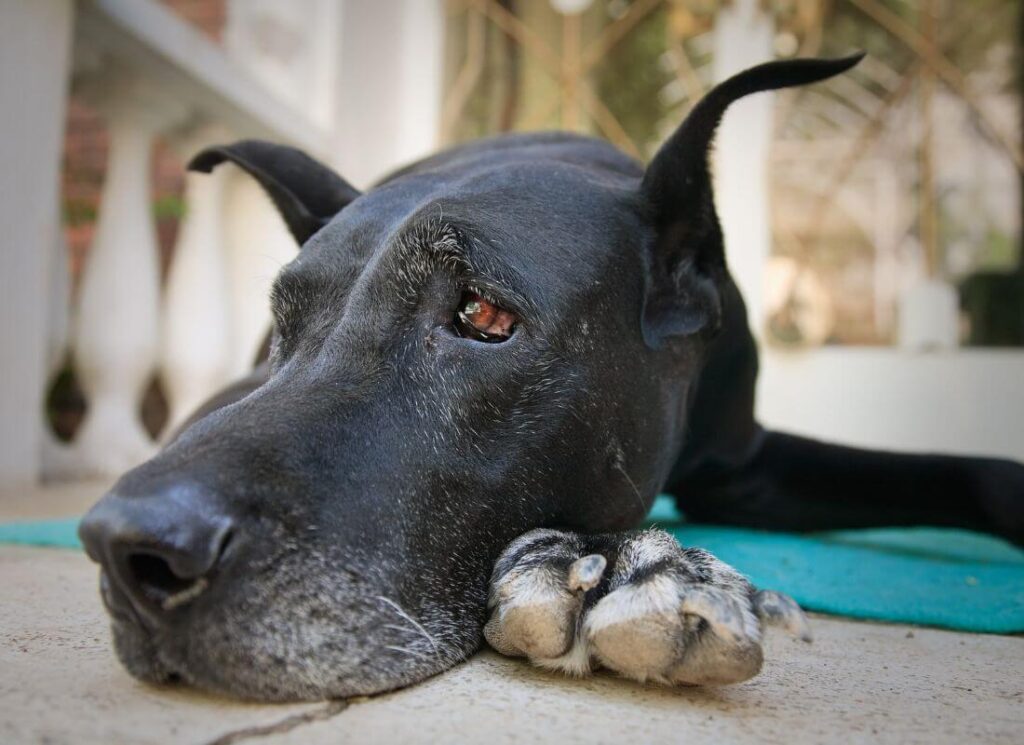
Do you have a breeder mentor?
What made you want to breed your dog in the first place?
Find a mentor who has vast experience breeding Danes.
Don’t just pick up advice from a backyard breeder (unfortunately, they hide in plain sight) or other pet owners. Find somebody who is truly focused on breed health and ethics. The Great Dane Club of America is a good place to start.
At some point, if you truly want to get ‘in’ to breeding, you’re going to see the difference between ‘well-bred’ and ‘purebred’ and you’re going to want a puppy from an excellent breeder
By seeking out their advice BEFORE you breed, you prove yourself early and are more likely to have access to quality puppies.
We are always happy to provide our honest opinion about your breeding program and breeding stock as well, just send us an email!
So You Bred Your Great Dane, Now What?
Breeding your Great Dane doesn’t stop with the choice to do it or not. Once the decision has been made, there are key considerations, especially for females!
Breeding a Great Dane Sire
Breeding the male comes with much less responsibility than breeding the female.
The biggest responsibility here is to make sure that your excellent, fully tested, and proven male is only being offered to excellent females who will be bred ethically, are fully health tested, and with a breeder who plans to support the puppies for life.
You will want to work with a qualified reproductive veterinarian to discuss semen collection vs. natural breeding.
Choose a female that compliments your male well and balances his faults. Do not just pick a random AKC Great Dane.
Breeding a Great Dane Dam
If your dog is the Dam, you have additional responsibility as your dog will be carrying the litter.
They say to never breed a dog you would not be ok losing.
The fact of the matter is that breeding and whelping can be dangerous.
You should be working with your veterinarian, and ideally, a Reproductive Veterinarian.
Not only that but raising Great Dane puppies is fun until it isn’t.
The mother may require medical support and even an expensive C-section. You MUST have money set aside for this.
Some of the puppies may die or need to be euthanized, and you MUST prepare yourself emotionally for this, too.
You will need an appropriate XXL whelping pen, puppy pads, blankets, a heat lamp, ribbons and collars for each puppy, and a kit full of additional birthing supplies and supplements that your veterinarian will recommend.
Because pregnancy, whelping, and nursing will use up a lot of important nutrients, your female will need to be on science-backed high-quality puppy food and supplements (talk to your veterinarian).
You will be up all hours of the night, especially at first (and that’s just with a healthy pregnancy and birth!).
There will be POOP and PEE everywhere.
You’ll have to pay for additional veterinary checkups for your dam, and the puppies will also need vaccinations, deworming, and possibly dew-claw removal (more $$!).
Registering and microchipping the litter will also cost money.
As the puppies grow they become tenacious, noisy, and HUNGRY! They also bite. A LOT.
A large litter can eat a lot of food, as can the mother who needs the nutrition to support the growing puppies.
Additionally, you’ll need to keep the puppies until 8 weeks of age and invest time and money into Puppy Culture so they are well-socialized.
This decision to breed could end up becoming the longest and most expensive, exhausting, frustrating, and rewarding 5 months of your life.
You’ll have to find quality, dedicated, and knowledgeable homes for the puppies, too. That is no easy task for new breeders, especially. You need to draw up contracts and be prepared to enforce them, too.
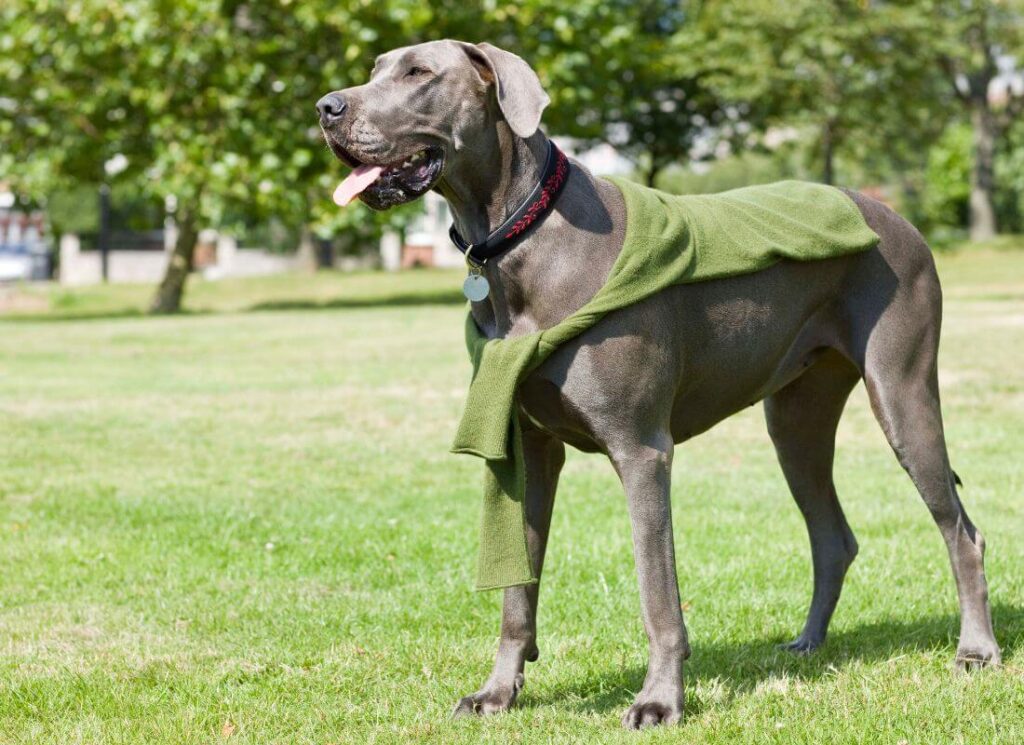
Can you support your puppy buyers?
Expect to have to provide support to all puppy buyers, for the life of their dogs.
They will send you text messages and phone calls and will need information about food, puppy biting, vaccines, and more.
Are you educated about Great Danes and prepared to field those questions?
If not, don’t breed your dog.
Are you also prepared to take those dogs back should any one of them have significant health or temperament issues, or if an owner cannot keep the dog?
Ethical breeders feel immense pain and guilt if any of their dogs end up needing rescue, expensive veterinary care, or euthanasia.
If you don’t care where the puppies end up once they leave the litter, you should not be breeding your dog.
Will you be proud of the results?
Are you willing to accept responsibility if puppies in the litter turn up with significant faults?
Will you be proud of your litter if they have flat feet, hunched backs, or timid personalities?
Are you going to feel good about seeing puppies turn up with droopy eyes, bloat, or wobblers?
Will you feel good about your decision to breed if your puppy buyers tell you that their dog has become aggressive or fearful and requires intense behavior modification?
Think about how the choices you make now will affect not only every puppy in the upcoming litter but your life for the next 5-15 years.
We Understand wanting to breed Great Danes, truly.
This is why we are here with a solid belief in education and ethics, wishing to share that foundation with others so that every puppy buyer receives a dog that has been truly set up for success.
Good breeders have waitlists. If you have to work hard to sell the puppies, that’s a good sign that you should NEVER HAVE BRED the dogs in the first place.
Do you wish to get into breeding ethically?
Do you desire to make sure that you are creating healthy, confident puppies?
We encourage you to keep learning. Find a high-quality breeder and mentor with them.
Purchase a dog that could be shown and consider going into the show ring. Get to know the people in your local breed club. Dig into the written standard and understand what the difference is between a well-bred dog and a purebred dog.
Lastly, be thoughtful.
We know you love your dog, but chances are you probably shouldn’t breed him or her.
Alternatives to Breeding
If you really want to breed so that your dog can ‘experience motherhood’ or so that your kids can ‘learn and experience it’, consider rescue instead.
Many rescues need temporary foster homes for whelping mothers, or temporary housing for young puppies until they are placed.
It’s a good opportunity to do a POSITIVE thing for your Community and still get to experience the sweet magic of tiny puppies!
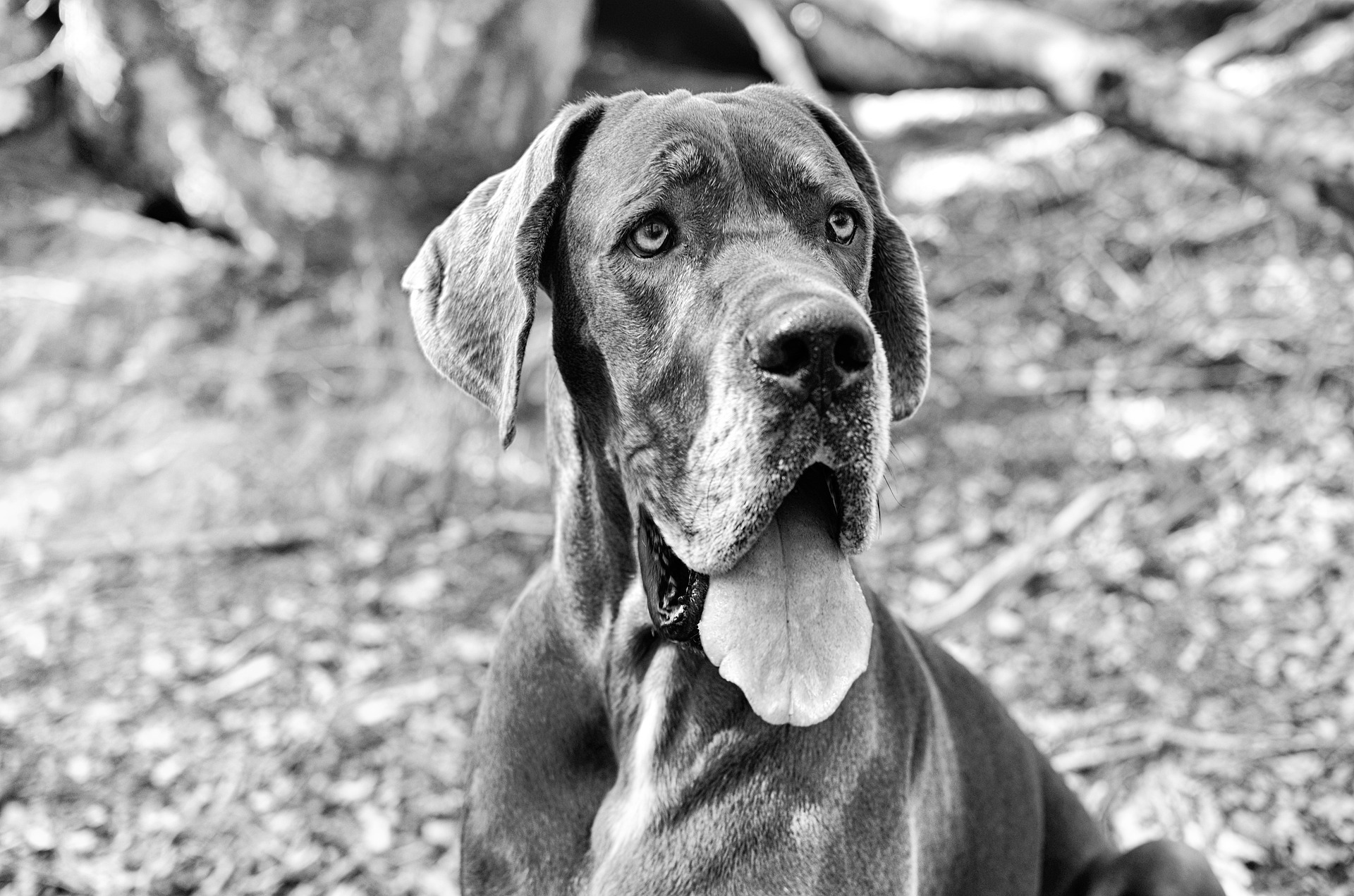
Comments
2 responses to “Should I Breed My Great Dane?”
Hello,
I have a beautiful Great Dane female I have had since she was 10 weeks old, she was an unexpected Christmas gift of love from a dear friend of mine. She arrived at the perfect time because I was grieving my beloved Friesian Horse I had rescued and had passed after 7 beautiful years together.
I am so great full to this article and is it possible to talk to you about breeding and or the best time to have her spayed? She is 2 1/2 years old and my Vet who also practices holistic approaches in her practice, suggested I could have her surgery where they remove just the uterus not the ovaries. She said it is a reality let new procedure and recommended two ets in my area that specialized in this. I want the very best for her and she said keeping the ovaries intact helps later on in her older years because she will have all the hormones etc with her ovaries intact.. do you have any feedback on this subject? I am feeling so nervous about the surgery and really wanted to breed her but after really doing the research I am feeling overwhelmed and of course want to respect the Breed and standards. She is my third Dane .. any exeperience and tips on how to prepare for the surgery, timing since her last heat cycle etc I would feel most grateful.
Thank you so much for this article and I hope to hear from you!
Lisa Fara
Loyal Friesians Horse Rescue, Inc.
Thanks for the comment! We are so glad to hear that you are wanting to take breeding seriously if you do it at all. It’s also very hard on the female dog, especially for owners new to breeding, so we always tell people to never breed a dog they aren’t prepared to lose. Top that off with needing to be fully responsible for every puppy created for the entirety of their lives, it’s a lot to think about! 🙂
Regarding spaying, that’s one place we don’t have a lot of resources yet as it’s something we are actively researching ourselves. The risks associated with keeping your dog intact include pyometra, mammary cancer, and accidental breedings. There are surgical risks as well, which can be minimized, so we’ve covered that in a blog post here: https://www.hellodanes.com/great-dane-surgery-what-to-ask-your-veterinarian/
Regarding keeping a dogs ovaries, I’d like to look more into this. Being a ‘new’ surgery, the only thing I imagine it prevents is accidental pregnancy and pyometra. The mammary cancer may still be an issue, I’m not sure. So you’d still be putting the dog through surgery for minor benefits – it feels like a middle ground that doesn’t really pick a side. At times, those hormones (from the ovaries) can also be problematic. I don’t believe most veterinarians would be super willing to do that procedure but we’re watching it closely! I apologize that we don’t have enough information to share on that.
We would not spay or neuter any dog prior to 18 or 24 months age, with some exceptions of course. To be fair, both of us here (who run this blog) have intentionally intact dogs that will NOT be bred. My own traditional veterinarian recommended keeping my male intact; this is not the right course for many owners or dogs…it’s so dependent on many factors. Which is why it’s hard to advise either way. Intact dogs are a massive responsibility for sure.
I believe for timing the dog should be solidly out of their heat cycle – your veterinarian should be willing to advise on this. Please keep us posted on anything you decide or learn!